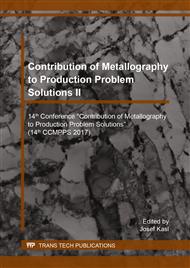p.183
p.189
p.197
p.205
p.212
p.218
p.224
p.230
p.239
Metallographic and Fractographic Evaluation of 3D-Printed Titanium Samples to Eliminate Unsatisfactory Mechanical Properties
Abstract:
Czech company ProSpon spol. s r.o. has introduced 3D printing technology in its production in 2015. This company operates in the field of development, manufacture and distribution of medical implants and instruments for orthopedics, traumatology and surgery. Therefore, the current intention is to employ Selective Laser Melting (SLM) technology for production of complex and patient-specific implants from titanium alloy Ti-6Al-4V. Nevertheless, first series of produced test specimens suffered from very low plasticity insufficient for the intended application. The reduction in elongation was almost 7fold compared to conventionally used wrought standard. From that reason, specimens were subjected to fractographic evaluation of fracture surfaces, but also metallographic evaluation. The main cause of the identified problem turned out to be porosity originating from inappropriate set-up of the machine. After the adjustment of process parameters new series of specimens were prepared in which the porosity was already significantly lower. Consequently, mechanical properties reached higher and better values.
Info:
Periodical:
Pages:
212-217
Citation:
Online since:
November 2017
Authors:
Keywords:
Price:
Сopyright:
© 2017 Trans Tech Publications Ltd. All Rights Reserved
Share:
Citation:


